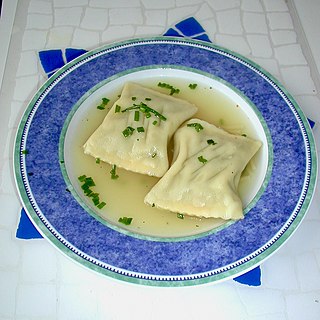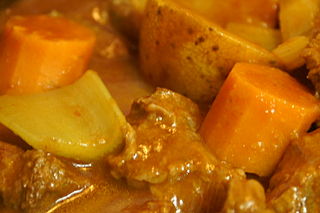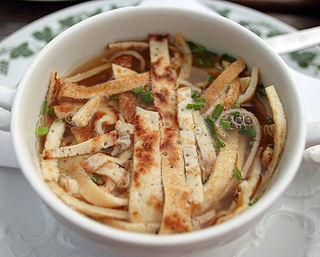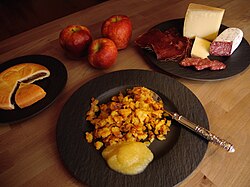
Gnocchi are a varied family of dumplings in Italian cuisine. They are made of small lumps of dough, such as those composed of a simple combination of wheat flour, potato, egg, and salt. Variations of the dish supplement the simple recipe with flavour additives, such as semolina flour, cheese, breadcrumbs, cornmeal or similar ingredients, and possibly including herbs, vegetables, and other ingredients. Base ingredients may be substituted with alternatives such as sweet potatoes for potatoes or rice flour for wheat flour. Such variations are often considered to be non-traditional.

The Grisons or Graubünden, more formally the Canton of the Grisons or the Canton of Graubünden, is one of the twenty-six cantons of Switzerland. It has eleven districts, and its capital is Chur. The German name of the canton, Graubünden, translates as the "Grey Leagues", referring to the canton's origin in three local alliances, the Three Leagues. The other native names also refer to the Grey League: Grischùn in Sutsilvan, Grischun in the other forms of Romansh, and Grigioni in Italian. Rhaetia is the Latin name for the area. The Alpine ibex is the canton's heraldic symbol.

Saumagen is a German dish popular in the Palatinate. The dish is similar to a sausage in that it consists of a stuffed casing; however, the stomach itself is integral to the dish. It is not as thin as a typical sausage casing. Rather it is meat-like, being a strong muscular organ, and when the dish is finished by being pan-fried or roasted in the oven, it becomes crisp.

Potato pancakes are shallow-fried pancakes of grated or ground potato, matzo meal or flour and a binding ingredient such as egg or applesauce, often flavored with grated garlic or onion and seasonings. They may be topped with a variety of condiments, ranging from the savory, to the sweet, or they may be served plain. The dish is sometimes made from mashed potatoes to make pancake-shaped croquettes. Some variations are made with sweet potatoes.

Maultaschen, lit. 'mouth bags') are a kind of large meat-filled dumpling in Swabian cuisine. They consist of sheets of pasta dough filled with minced meat, smoked meat, spinach, bread crumbs and onions and flavored with various herbs and spices. Maultaschen are typically 8–12 centimetres across. They are square or rectangular in shape.

Rösti or rööschti is a Swiss dish consisting mainly of potatoes, sautéed or shallow-fried in a pan. It was originally a breakfast dish, commonly eaten by farmers in the canton of Bern, but is now eaten all over Switzerland and around the world. The French name röstis bernois directly refers to the dish's origins.

Swiss cuisine is an ensemble of national, regional and local dishes, consisting of the ingredients, recipes and cooking techniques developed in Switzerland or assimilated from other cultures, particularly neighboring countries. The diversity and comprehensiveness of Swiss gastronomy reflects the linguistic, cultural and geographical diversity. The climate of Switzerland allows for a large variety of terroirs, and therefore a wide range of indigenous food, from simple cereals to refined products like cheese and wine.

A frikadelle is a rounded, flat-bottomed, pan-fried meatball of minced meat, often likened to the German version of meatballs. The origin of the dish is unknown. The term Frikadelle is German but the dish is associated with German, Nordic and Polish cuisines. They are one of the most popular meals in Poland, where they are known as kotlety mielone.

Scouse is a type of stew typically made from chunks of meat with potatoes, carrots and onion. It is particularly associated with the port of Liverpool, hence the inhabitants of that city are often referred to as "scousers". The word "scouse" comes from lobscouse, a stew commonly eaten by sailors throughout northern Europe in the past, and surviving in different forms there today.
Helvetisms are features distinctive of Swiss Standard German, that distinguish it from Standard German. The most frequent Helvetisms are in vocabulary and pronunciation, but there are also some distinctive features within syntax and orthography.
Swiss Standard German, or Swiss High German, referred to by the Swiss as Schriftdeutsch, or German: Hochdeutsch, is the written form of one of four official languages in Switzerland, besides French, Italian, and Romansh. It is a variety of Standard German, used in the German-speaking part of Switzerland and in Liechtenstein. It is mainly written, and rather less often spoken.

Flädle is a southern German garnish and soup ingredient from the region of Baden-Württemberg consisting of savory pancakes, cut into ribbons.

Gachas is an ancestral basic dish of central and southern Spain. It is a gruel whose main ingredients are flour, water, olive oil, garlic, paprika and salt.

Wiener schnitzel, sometimes spelled Wienerschnitzel, is a type of schnitzel made of a thin, breaded, pan-fried veal cutlet served without sauce.

Wähe is a baked dish typical of Swiss and Alemannic (German) cuisine. A wähe consists of a casing and a topping of a custard enveloping either fruit, vegetables or cheese. The custard and fruits or vegetables are baked together. The preparation is thus very similar to that of the French quiche or tarte.
Spätzla, Spätzle [ˈʃpɛtslə] or Spatzen are Swabian or Alemannic pasta of an elongated shape which is served as a side dish or with other ingredients like cheese and onion as a main dish. A similar round shape, simplified in production, is native to the pre-Alpine Allgäu regions of Bavarian Swabia and Baden-Württemberg as Knöpfle.

Onion soup is a type of vegetable soup with sliced onions as the main ingredient. It is prepared in different variations in many countries, the most famous of which is the French onion soup or Parisian onion soup. Because of the affordable ingredients, it has primarily been a dish for the poor for a long time.
Spanish Fricco, also spelled as Spanish frikko, is a stew of Westphalian cuisine in Germany. It is a hearty dish prepared primarily using diced beef, potatoes and onions, typically in a cream soup base prepared using butter and sour cream. Pork and lamb has also sometimes been traditionally used. A Frikko recipe is included in the Practical Cookbook first published by Henriette Davidis in 1845. The dish has sometimes been noted for having a relatively unappealing visual appearance when completed.
Frisian cuisine consists of the traditional recipes and cooking methods of the historic region of Frisia, which is in present-day Germany and the Netherlands. Frisian cuisine is diverse, drawing from both land and sea. Most dishes, excluding desserts, are made of fish or potatoes, though there are several dishes based on other ingredients. Especially in West Frisia, the food resembles that of the Dutch Cuisine, though East Frisia and North Frisia present dishes that are very much unique to the region.

Älplermagronen is a dish from the Alpine regions of Switzerland, consisting of pasta, potatoes, cream, cheese, and onions. The name is made up of "Älpler" as a designation for the Alpine herder and "Magronen", which was taken as a loan word from the Italian word maccheroni.















